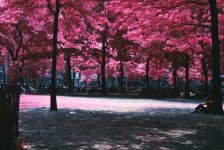I have used Kodak EIR film quite recently.
When in Italy back in June I found a store that had five rolls in their film cooler. I bought them out. Then the next month in Prague I found another store that had three more rolls that I scooped up. Believe it or not I found two more rolls in a store in Vienna but I never had a chance to expose it!
I used an orange filter both over a lens and behind a pinhole body cap on my M7. I have the resulting images posted on my web site (
click here) along some that I took back in 1973 when I was teenager.
The film can be processed using the E6 process. I was concerned that the film canister warns about processing in total darkness -- that is any IR sensors in the E6 processing machine need to be turned off before running the EIR film through it.
But two different shops with equally difficult language barriers processed the film for me and there was absolutely no fogging.
You should check with a local lab about IR film processing first but frankly I'm not so sure that this is really a problem with modern E6 processing machines.
The film was loaded and unloaded in subdued light (i.e., in the shade) again with no problems with fogging.
I did no bracketing to speak of. I set the ISO setting to 200 (and even once by mistake to 100) and let the M7's built in meter do the work for me. Almost all of the images taken in open sun were perfectly exposed.
I have probably 20 rolls of EIR in the freezer back home so I will be revisiting EIR film again when I return home.
Where do we find the images that you just uploaded?


